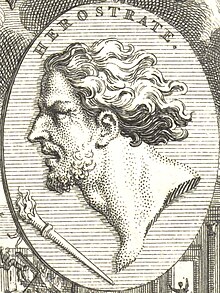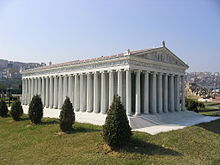Herostratus
Herostratus | |
|---|---|
| Ἡρόστρατος | |
 Non-contemporary depiction | |
| Born | |
| Died | c. 356 BC Ephesus |
| Cause of death | Execution |
| Nationality | Ephesian |
| Known for | Destroying the Temple of Artemis at Ephesus—and, concomitantly, seeking fame at any cost |
Herostratus (
History

Archeological evidence indicates the site of the Temple of Artemis at Ephesus had been of sacred use since the Bronze Age,[1] and the original building was destroyed during a flood in the 7th century BC.[2] A second temple was commissioned by King Croesus of Lydia around 560 BC and built by Cretan architects including Chersiphron, constructed largely of marble, and measuring 103 metres (337 ft) long and 55 metres (180 ft) wide with its pillars standing 12 metres (40 ft) tall.[3] The sculpted bases of the pillars contained life-sized carvings and the roof opened to the sky around a statue of Artemis.[3] The second temple was included on an early list of the Seven Wonders of the Ancient World by Herodotus in the 5th century BC, and was well known in ancient times.[4]
Little is known about the life of Herostratus, though it is thought he may have been someone of low social standing, a non-
But the iniquity of oblivion blindly scattereth her poppy, and deals with the memory of men without distinction to merit of perpetuity. [...] Herostratus lives that burnt the Temple of Diana, he is almost lost that built it [...] Who knows whether the best of men be known? or whether there be not more remarkable persons forgot, than any that stand remembred in the known account of time?[10]
Work on a third temple at the site began in 323 BC, resulting in a larger and more ornate temple that would be included by Antipater of Sidon as one of Seven Wonders of the Ancient World.[11]: 417–418
Legacy
Herostratus' name lived on in classical literature and has passed into modern languages as a term for someone who commits a criminal act in order to achieve notoriety. According to Julia H. Fawcett, Herostratus "exemplifies a figure asserting his right to self-definition, one who strikes out against a history to which he is unknown by performing himself back into that history—through whatever means necessary." The term "Herostratic fame" refers to Herostratus and means "fame [sought] at any cost".[12]: 33
In literature and the arts
- Chaucer makes reference to Herostratus[13] in The House of Fame: "I am that ylke shrewe, ywis, / That brende the temple of Ysidis / In Athenes, loo, that citee." / "And wherfor didest thou so?" quod she. / "By my thrift," quod he, "madame, / I wolde fayn han had a fame, / As other folk hadde in the toun..."[14]
- Many authors from 16th- and 17th-century Spain refer to Herostratus to represent someone who will do anything to gain notoriety. He is discussed in Chapter 8 of the second part of Miguel de Cervantes' Don Quixote (1615),[15] along with Julius Caesar and Hernán Cortés. Don García, the protagonist of Ruiz de Alarcón's La verdad sospechosa (Suspect Truth), compares his feats to the ancient character.[16]
- Colley Cibber's Richard III (1699) contains the oft-quoted line, "The aspiring youth that fired the Ephesian dome / Outlives in fame the pious fool that rais'd it."[12]: 33
- In the chapter titled "Dreams" in Herman Melville's Mardi, and a Voyage Thither (1849), the protagonist states, "[W]hoso stones me, shall be as Erostratus, who put torch to the temple..."[17]
- Jaroslav Hašek, in the preface of his last novel The Good Soldier Švejk (1921–1923), compared Herostratus to the protagonist Švejk in praise of the latter.
- In his 6 October 1939 speech to the Berlin Reichstag, Adolf Hitler made a reference to Herostratus, making a contemporary comparison: "It is clear to me that there is a certain Jewish international capitalism and journalism that has no feeling at all in common with the people whose interests they pretend to represent, but who, like Herostratus of old, regard incendiarism as the greatest success of their lives."[18]
- The protagonist of the 1967 film Herostratus hires a marketing company to turn his suicide-by-jumping into a mass-media spectacle.
- In Gore Vidal's 1970 novel Two Sisters, the real-life story of Herostratus serves as a sub-plot.
- In Grigori Gorin's 1972 play Forget Herostratus!, a "theater man" from the present observes the judgement of Herostratus in order to understand the source of the disaster that plagues humanity.
- Jean-Paul Sartre's short story "Erostratus" (1939) is directly based on the story of Herostratus.
- Andrei Tarkovsky's 1979 film Stalker makes reference to Herostratus.
- The tale of Herostratus is directly referenced in two songs from the If These Trees Could Talk album Above the Earth, Below the Sky (2009).
- In for the lulz", sending the town into a frenzy of violence.
See also
References
- S2CID 164151382.
- ^ Pausanias, Description of Greece 7.7 - 8.
- ^ ISBN 978-1-62998-477-3.[page needed]
- ^ Rawlinson, George (1859). The History of Herodotus. Vol. 1. New York: D. Appleton and Company.[page needed]
- ^ ISBN 978-1-59486-513-8.
- ^ Valerius Maximus, Memorable Deeds and Sayings, 8. 14. 5: "A man was found to plan the burning of the temple of Ephesian Diana so that through the destruction of this most beautiful building his name might be spread through the whole world." Valerius Maximus, VIII.14.ext.5
- ISBN 978-0-19-815243-9.
- ISBN 978-0-87338-818-4.
- ISBN 978-1-78656-368-2.
- ^ Browne, Thomas (1907). Sayle, Charles (ed.). The Works of Sir Thomas Browne. Vol. 3. Edinburgh: John Grant. p. 139.
- ^ Price, J. R., & House, H. W., Zondervan Handbook of Biblical Archaeology (Grand Rapids: Zondervan, 2017), pp. 417–418.
- ^ ISBN 978-0-472-11980-6
- ^ Bowman, James (18 April 2001). "From Heroes to Herostratus". JamesBowman.net. Archived from the original on 12 October 2011. Retrieved 8 March 2020.
- ^ Chaucer, Geoffrey (1379–1380). "The House of Fame". The Works of Geoffrey Chaucer. Georgetown University. Archived from the original on 10 August 2011. Retrieved 19 September 2011.
- ISBN 978-1-60384-115-3.
- OCLC 36714819.
- ^ Melville (1855). Mardi, and a Voyage Thither. Vol. 2. New York: Harper & Brothers. p. 61.
- ^ Skene, Gordon (6 October 2014). "Adolf Hitler Addresses The Reichstag – October 6, 1939 – Past Daily Reference Room". Past Daily. Retrieved 8 March 2020.
Bibliography
- Smith, William, ed. (1867). "Herostratus". Dictionary of Greek and Roman Biography and Mythology. Vol. II. Boston: Little, Brown and Company. p. 439.
External links
 The dictionary definition of herostratic fame at Wiktionary
The dictionary definition of herostratic fame at Wiktionary Media related to Herostratos at Wikimedia Commons
Media related to Herostratos at Wikimedia Commons
